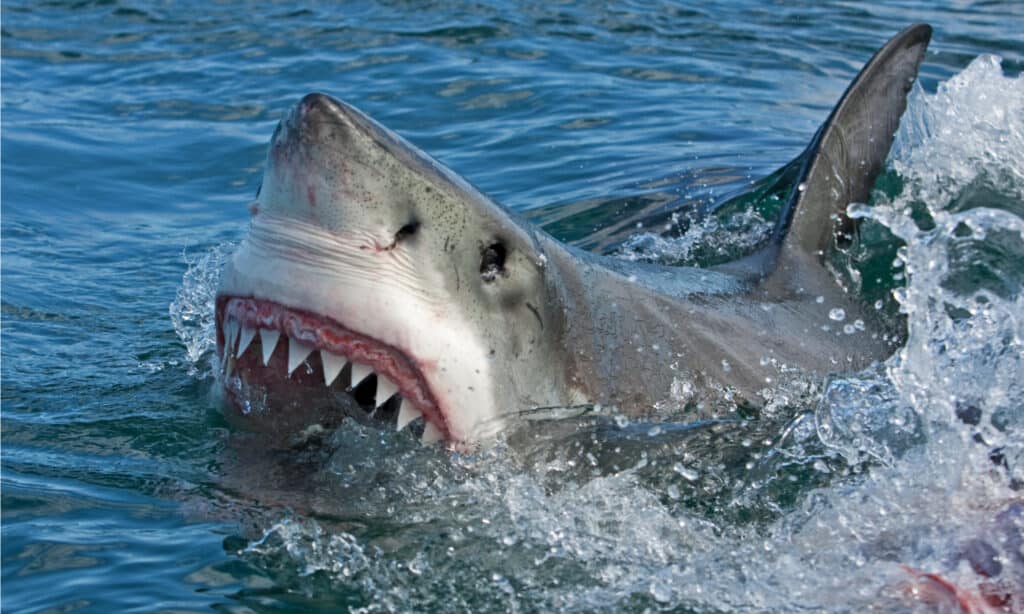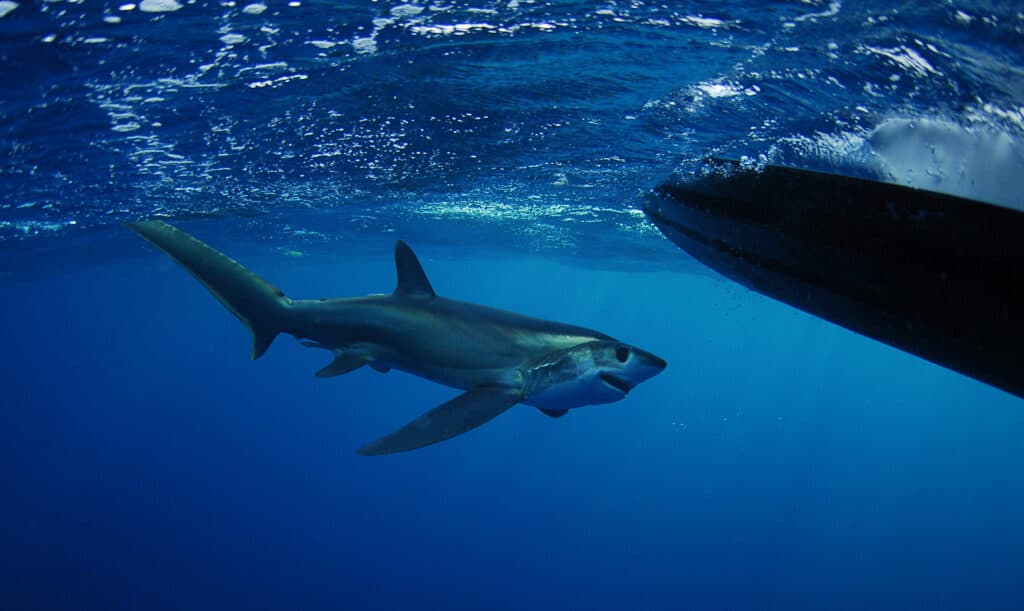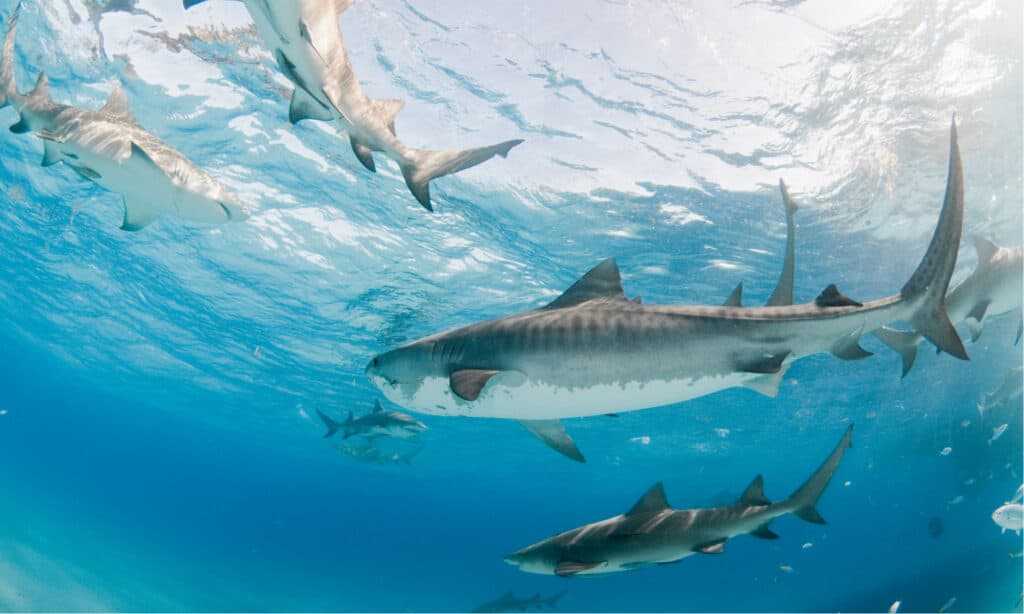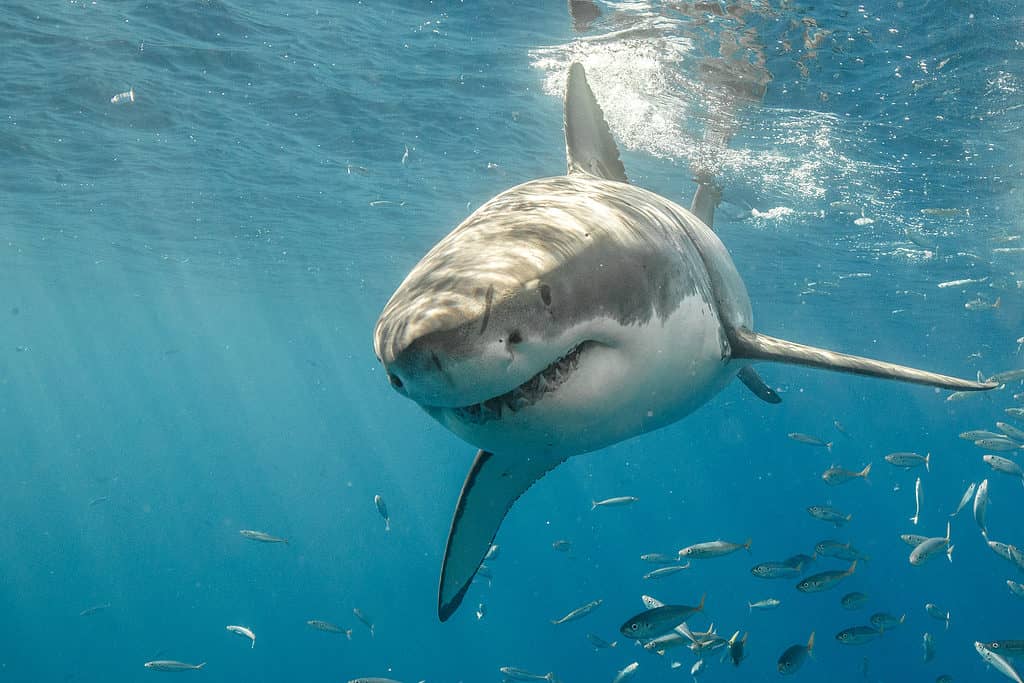Sharks don’t use a voice to communicate. Instead, they talk to each other through body language and swimming patterns. An arched back signals “go away,” while a tail slap indicates “I’m going to steal your food.”
Many of their postures complement each other. For example, a shark may drop its pectoral fins, arch its back, and employ a special swimming pattern as part of an agonistic display. Sharks commonly use these three displays when they want something pursuing them to back off.
Are you ready to speak shark? Join us as we explore the fascinating ways sharks communicate!
1. Gaping

Gaping is a behavior sharks use to threaten others and express irritation.
©Martin Prochazkacz/Shutterstock.com
One of the ways sharks communicate with each other is by gaping. Sharks gape as a way of threatening other sharks, or out of irritation. This is where they emerge from the water and open their jaw, and it can look a bit like they’re yawning.
Great whites are famous for gaping, but their not the only shark that talks this way. Other species, like the Caribbean reef shark, also love to gape.
Gaping involves a little bit more than just opening their jaw. Sometimes the shark will also roll on their side, and swim slowly along the surface. As for the jaw, it doesn’t always stay open the entire time. White sharks in Australia like to open and close their mouths, creating a partial gape as they swim about.
2. Tail Slaps

Thresher sharks will slap their tails to communicate dominance and defend food sources.
©FtLaud/Shutterstock.com
Another way sharks communicate with each other is by slapping their tails. This behavior is common when sharks are competing for food or defending a meal. A tail slap can be a way of saying, “Back away, this food is mine”, or “I’m coming to take your food!”.
The slap may help communicate to the other shark how strong its opponent is. The intensity fully depends on the strength of the shark. This behavior is an example of sharks communicating with surface sound, which is something whales also do.
3. Fin Biting

Male sharks will bite females to get their attention and initiate mating.
©Fiona Ayerst/Shutterstock.com
Sharks bite one another, but not as a sign of aggression. Instead, this seemingly strange behavior is part of a courtship ritual. Male sharks bite to attract the female’s attention. Females of various shark species often bear scars from these encounters, but the bite marks are less severe than those from feeding bites. Some species, such as female tiger sharks, have adapted by developing thicker skin than their male counterparts.
4. Pectoral Fin Drops

Sharks can drop their pectoral fins, and hunch their back to communicate that they’re annoyed.
©cbpix/Shutterstock.com
Sharks sometimes drop their pectoral fins when they sense a threat. Along with the dropping of their fins, they usually arch their back and swim in loops. This is a way for sharks to use their body language to say, “Go away”.
Along with communicating irritation, the pectoral fins also help sharks:
- Steer
- Speed up
- Brake
A shark’s pectoral fins help them accomplish all sorts of tasks! For one, they make it possible for them to carry things, and quickly change direction and speed. And they also provide sharks with a lift.
5. Back Arching or Hunched Back

Sharks may arch or hunch their backs and swim in a special pattern before making an attack.
©iStock.com/ShaneMyersPhoto
Sharks arch or hunch their back as a way of saying, “Get away from me”. In other words, when a shark arches its back, it needs space. If the thing pursuing the shark backs off, all can be well. However, if the pursuer continues, the shark will likely attack.
For instance, attacks are more likely to happen when a diver enters the shark’s territory. From the shark’s perspective, these attacks are defensive. The sharks aren’t trying to eat the person; they’re just using their teeth to chase the diver away.
That’s right, sharks attack to protect themselves, not just because they’re hungry. And it’s common for them to give numerous warnings before making a move.
Before such defensive attacks, sharks often do a special swimming pattern called an agonistic display. In this display, the shark shakes its head, swims funnily with a hunched back, and puts its side fins down while pointing its snout up.
Gray reef sharks are well known for using the agonistic display when a diver is chasing them. They’ll make sharp, fast movements, and hunch their posture. The shark also swims more exaggeratedly in a wide, wavy path.
The photo featured at the top of this post is © Matt9122/Shutterstock.com
Thank you for reading! Have some feedback for us? Contact the AZ Animals editorial team.






